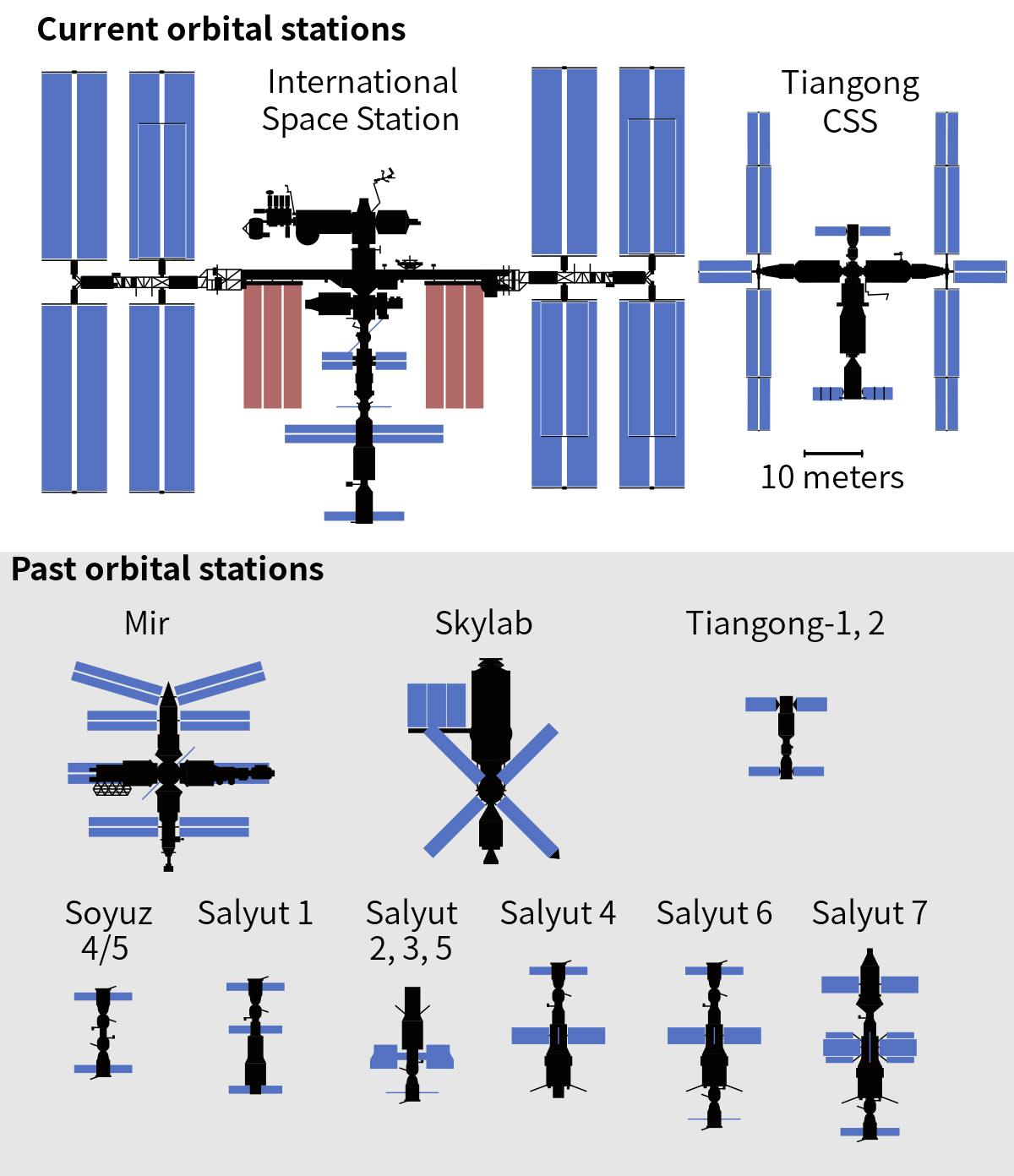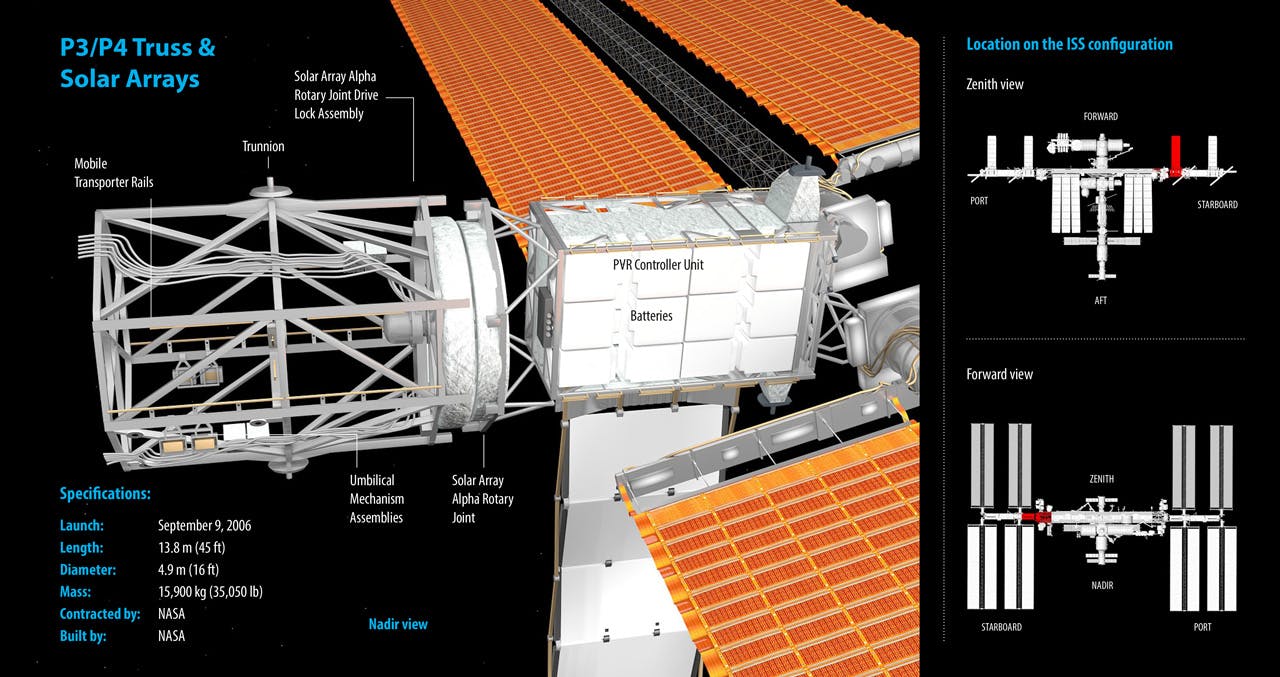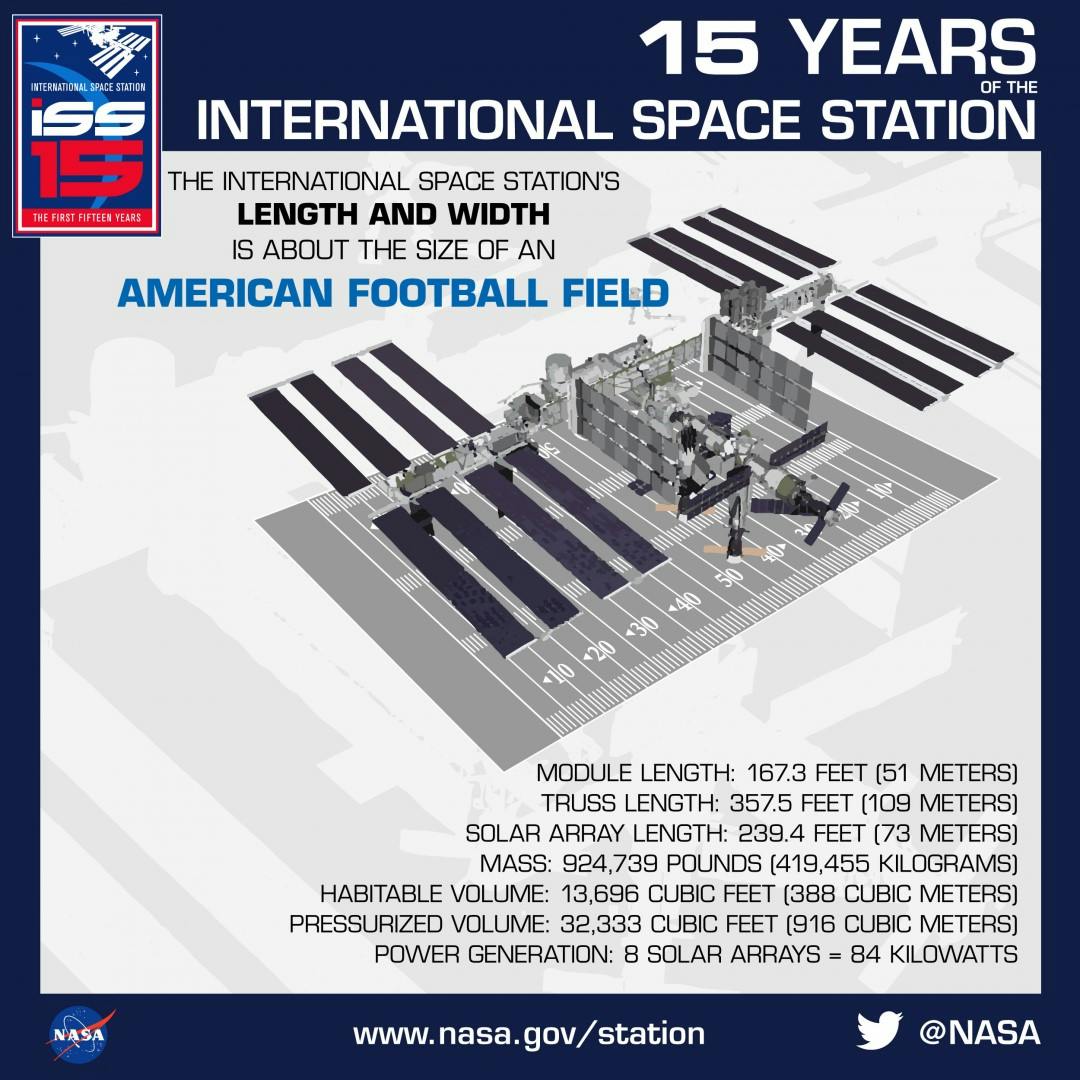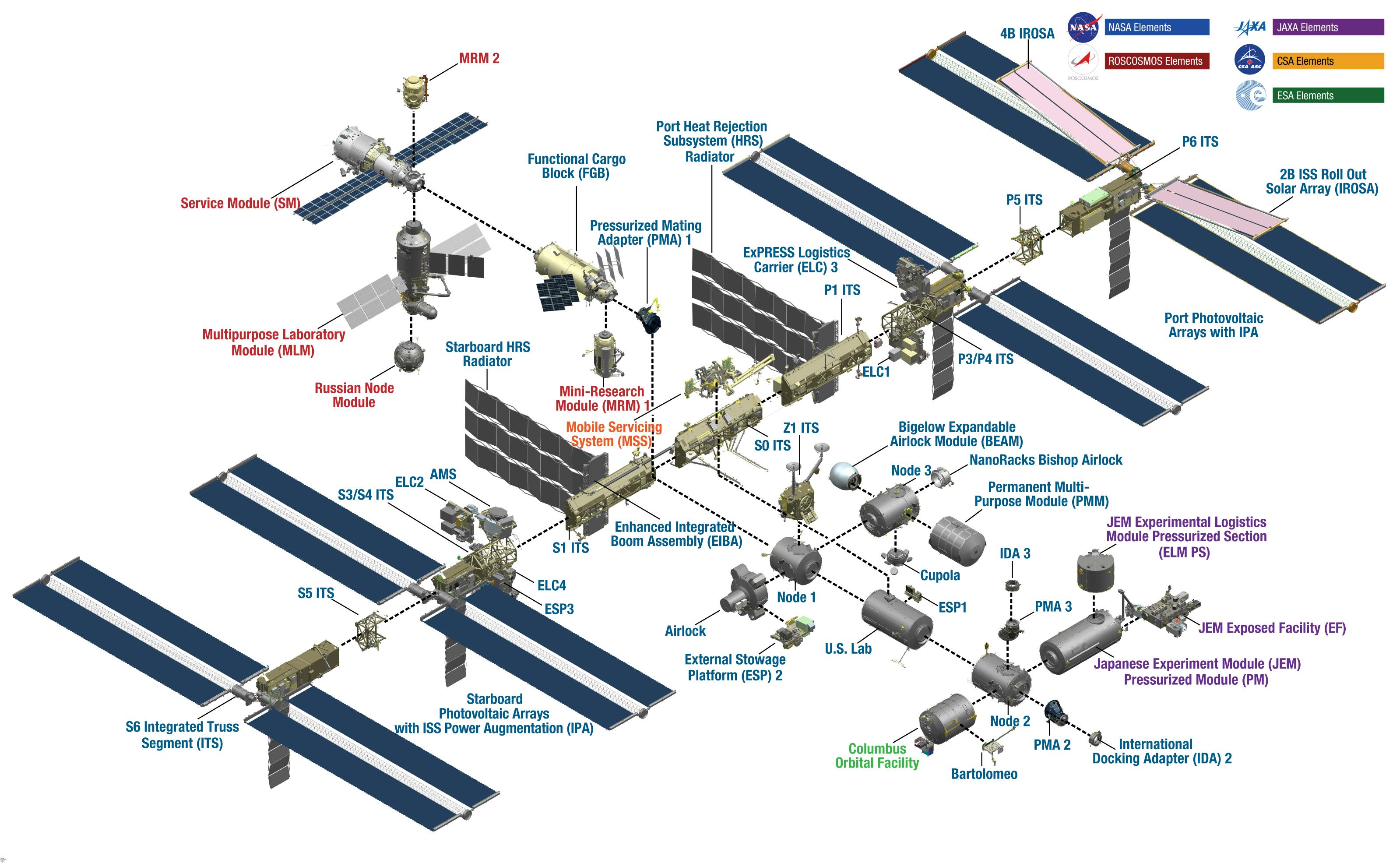Space: a few letters, but the first thing that comes to mind when I hear this word is ISS. The International Space Station, or ISS, is a big station or artificial satellite that revolves around the lower Earth's orbit.
In this article, I will take you on a tour of the International Space Station and discuss its upcoming space operations as well as recent updates. The International Space Station is a base for all the space activities that have been done so far. It is the biggest artificial body till now in space. The first component of its base was launched into lower Earth orbit in 1998. The most prominent structure ever created and placed in space is a multi-nation structure.
On board the International Space Station (ISS), crew members can do research in plant biology, human biology, physics, astronomy, meteorology, and other fields. The ISS serves as a laboratory for studying microgravity and the environment in space. The station is a great place to test the equipment and parts that will be used on missions to the moon, Mars, and other celestial bodies.
No single government or entity owns this artificial satellite or station. It involves cooperation or collaboration among 15 countries. The United States, Russia, Canada, Japan, Belgium, Denmark, France, Germany, Italy, the Netherlands, Norway, Spain, Sweden, Switzerland, and the United Kingdom are among them.
NASA, Roscosmos, JAXA, ESA, and CSA make up the five space organisations collaborating on this multinational endeavour.
"We are separated by boundaries on the ground and united in Space."
Let's go back in time to see how the ISS was launched from Earth and built-in space.
Fact: The International Space Station (ISS) was assembled in space after being launched piece by piece on space shuttles.
People used to think of a space station as something out of science fiction, but in the 1940s, it became clear that the US could actually build one. As the Space Age began in the 1950s, designs of "space planes" and space stations were all over the news. The first basic space station was built in 1969 when two Russian Soyuz spacecraft were connected. Subsequent stations and advances in space technology led to the start of construction on the International Space Station (ISS) in 1998, with the help of the first reusable spacecraft ever created: the American shuttle.
Foundation of ISS
The US-funded and Russian-built Zarya Control Module was the first component launched by Russia on November 20, 1998, followed by US's Unity Module on December 4, 1998, during the STS-88 mission. The first stage of building the largest orbiting laboratory outside Earth involved connecting Unity with the Zarya module. On December 6, 1998, two members of the STS-88 mission captured Zarya with the robotic arm and locked it with the Unity module in the shuttle's cargo bay.
After coupling, astronauts performed spacewalks to establish power, data, and utility connections.
The Russian Aviation and Space Agency (now Roscosmos) cosmonauts Yuri P. Gidzenko and Sergei K. Krikalev, along with NASA astronaut William M. Shepherd, arrived at the space station on November 2, 2000, and immediately got to work bringing it to life. They collaborated with three visiting space shuttle crews throughout their four-month mission to finish building the ISS and install and activate the life support and communication systems.
The base was completed, and it was now time to construct the upper portion, which was accomplished by sending all modules in stages via space shuttles.

Components of ISS
All the components are a bunch of shapes we studied in first grade, like triangles, canisters, spheres, and beams.
On Earth, constructions like bridges use triangles and beams for strength. Numerous triangular beams and constructions make up the truss that serves as the station's framework (Integrated Truss Structure).

Solar panels are installed to generate electricity by trapping sunlight, and waffle-shaped radiators to eliminate the extra heat generated in the whole station. Ni-Hydrogen (Ni-H2) batteries were intended to be used as the principal electrical energy storage system for the International Space Station (ISS). Later Lithium-ion batteries replaced these Ni-H2 batteries. The solar arrays on the space station produce the station's electricity while simultaneously charging batteries to be discharged during eclipses.

Canadarm, a robotic arm built by Canada, is one of the significant components that help grapple and move extensive modules in space by controlling it from the inside (just like a joystick). It assists in building the station by using a grapple device to lift and move modules or positioning astronauts to operate on the station. It contributes to the construction of the station. Amazing fact: It can dance too - Watch Here

While labs on the International Space Station (ISS) are used to research life sciences, physical sciences, technological development, and remote sensing for a wide range of customers in the academic, government, and private sectors. Destiny, the first lab built by the United States to go on board, increased onboard living space, followed by ESA's Columbus laboratory and Japan's Kibo Laboratory.
"The International Space Station was designated as a U.S. National Laboratory on December 30, 2005, by Congress to increase the research opportunities of this unrivalled platform. This has made space research and development accessible to a wide range of commercial, academic, and government users." [13]
Researchers in the United States from small businesses, research institutes, Fortune 500 firms, government agencies, and other organisations can now access this cutting-edge microgravity research platform if they're interested in using it to address challenging issues on Earth. In simple terms, one can experiment with their research on the ISS.
It took almost 10 years and around 30 space missions to establish the whole ISS in space.
We have been battling diseases that affect millions of people for generations, but the space station offers fresh insights into the problem. Numerous studies of human health in space have been conducted and are still being conducted to sustain astronaut health. These studies have yielded important results that benefit us on Earth and our astronauts. These discoveries led to novel ways of studying bacterial activity, decreasing bone loss, and developing ground-breaking wound-healing techniques. Advancements in telemedicine, disease models, psychological stress response systems, nutrition, and cell behaviour, to name just a few, have all resulted from the application of studies conducted in space to human health back on Earth. For further details - Human Health
Features of ISS
The International Space Station (ISS) is roughly the size of a football field, measuring 357 feet (109 metres) from end to end and weighing almost one million pounds. Its dimensions are as follows: the truss length of the station is 357.5 feet (approximately 109 metres), the solar array length is 239 feet (73 metres), and the module length is 167 feet (51 metres). The ISS has six sleeper quarters, a gym for astronauts, two bathrooms, and a 360-degree bay view (perfect for sightseeing).
The International Space Station (ISS) is the largest crewed spacecraft ever launched. It is made up of hundreds of main and smaller parts. The ISS has the same amount of pressurised space as a Boeing 747, which is 32,333 cubic feet.
As per NASA, "The Solar Array Wings are each 34 m (112 ft) long by 12 m (39 ft) broad, weigh about 1,100 kg (2,400 lb), and this acre of solar panels provides the 75 to 90 kilowatts of power required for the ISS. The wiring for the electrical system is eight miles long. More than 40 homes on Earth might be powered by the combined output of the four sets of arrays, which range in power output from 84 to 120 kilowatts. and This electricity is also used to produce oxygen for astronauts by using 'electrolysis', in which electricity splits water into hydrogen and oxygen. "

Location in orbit and speed
The space station orbits the planet at an average altitude of 420 kilometres (227 nautical miles) above Earth. Numerous spacecraft orbit in the exosphere or lower, including the International Space Station (ISS). The ISS travels at a speed of about 28,000 kilometres (17,500 miles) per hour. With this much speed, the ISS rounds the Earth every 90 minutes at this pace, giving the crew 16 sunrises and sunsets each day. One can look at the sunrise and sunset 16 times each day. There's no need to wait a whole day to capture one of the most beautiful events in nature.
Materials and Tools or Gadgets
We are working in space. For that, strong but light in-weight materials that can shield the crew from the solar wind, and asteroids, must withstand a steady rain of dust-sized meteoroids, many moving faster than a speeding bullet!
Titanium, Aluminum and Kevlar (used in bulletproof vests worn by police) are some of the most critical materials used while building ISS. The aluminium shell of each module is encased in layers of Kevlar, ceramic textiles, and other cutting-edge materials that can reach a thickness of 10 cm.
Now, some essential tools that are usually used by the ISS crew (and help the crew in doing so many essential tasks related to maintenance, repairing etc. ) include:
Pistol - Grip Tool: A hand drill with a torque range of less than 1 to 38 foot-pounds of force and can run between 5 to 60 rpm, with chargeable metal hydrodynamic batteries that can hold more charge at high temperature - ideally suited for the station's orbital cycle of shadow and sunlight.
Robot Crane (Canadarm): A large robotics arm developed by Canada to help astronauts move large equipment during construction. An integrated track into the truss is where the arm travels. Astronauts inside the station use closed-circuit television to direct the crane. In contrast to the shuttle arm, the Canadarm 2 incorporates force sensors to simulate "touch" and an autonomous collision avoidance system.
Safety Tethers: Not an exciting tool, but they still help the astronauts during their spacewalk as it is attached at their waist with a 25-foot tether made of heat-resistant webbing.
T Analyzer: Two inches high-performance spectrometer placed in astronauts' chest that can detect water or fluid leakage, seeping rocket fuel or escaping oxygen. If this is used, it's easier to find the leakage locations.
(For more details on these above-discussed tools - Astronaut Tools)

Other amazing gadgets include the Global Ecosystem Dynamics Investigation (GEDI), Oxygen Generation System (OGS), Mobile Servicing SystemAvian Development Facility (ADF), Advanced Resistive Exercise Device (ARED), Robonaut, Zero-Gravity 3D Printer, and many others.
Now, what's next for the ISS
As discussed, so many things above are related to the ISS's journey from its birth till today. The ISS has been operated for more than 20 years by scientists and researchers to study biology, physics, biomedicine, materials science, and Earth and space science. The ISS crew has also played an essential role in the experiment by voluntarily serving as test subjects for studies on how humans adapt to living and working in microgravity.
The first decade was dedicated to ISS assembly; then, the second decade was dedicated to research, development, understanding, and performing various experiments in space. Now in its third decade, the ISS and NASA aim to validate deep space exploration and human research technologies that will continue to benefit humanity in terms of health and the environment. Currently, there are seven people on board the ISS.
NASA officially announced that they are planning to decommission the ISS in 2030. Source: npr.org
"INSIGHT - Kessler Syndrome, a scenario in which there is so much trash in space that it keeps producing more debris, making it difficult for astronauts, satellites, and mission planners to carry out their plans, is likely one of the reasons why NASA cannot allow the ISS to float out in space indefinitely."

The ISS is anticipated to remain operational until 2030, according to assessments. As per the research, Engineers will strategically place the ISS's reentry point over a location known as the South Pacific Oceanic Uninhabited Area by gradually lowering the operational altitude over several years. Also known as the location of satellite demise. This region of the Pacific Ocean, which goes by Point Nemo, is utterly remote. Unbelievable as it may seem, the ISS crew is currently the closest human group near Point Nemo. But only a portion of the satellite will reach Point Nemo; the majority is expected to burn up in the atmosphere during reentry. As a result, the entire satellite won't plunge into the water. No sea life would be harmed during this crash as, in this location, there is an extensive system of rotating ocean currents that do not allow any aquatic life.
According to reports, Russia intends to leave the International Space Station after 2024 and will launch their space station. That is one of the reasons why NASA is calling down the ISS. Besides Russia, Other nations, including India, are also planning to launch their space stations soon. Source: NY Times
Latest Developments
With the addition of two lab modules, Wentian ("Quest for the Heavens"), launched on July 24, 2022, and Mengtian (means "Dreaming of the Heavens"), phase one development of China's Space Station named Tiangong (means "heavenly palace") was completed by late 2022.
Also, India is setting its eye on building its own space station by 2035. Source: Hindustan Times
Space is beyond our imagination. As a species, we're all doing what we can to explore space and gain a better understanding of the universe, which is both breathtakingly beautiful and profoundly terrifying.
"SPACE UNITES US ALL"
"Let The Journey Continues "
.
.
.
References
[1] Canadarm dance ESA. Available at: https://www.esa.int/ESA_Multimedia/Videos/2021/05/Canadarm_dance.
[2] Eugen (2017) ISS Integrated Truss Structure, SpaceCraftEarth. Available at: https://spacecraftearth.com/portfolio/iss-integrated-truss-structure/
[3] Garcia, M. (2016) International Space Station Facts and Figures, NASA. NASA. Available at: https://www.nasa.gov/feature/facts-and-figures
[4] Howell, E. (2022) International Space Station: Facts about the Orbital Laboratory, Space.com. Space. Available at: https://www.space.com/16748-international-space-station.html
[5] International Space Station - definition and synonyms of International Space Station in the English Dictionary, INTERNATIONAL SPACE STATION - Definition and synonyms of International Space Station in the English dictionary. Available at: https://educalingo.com/en/dic-en/international-space-station
[6] Magazine, S. (2007) Tools of the (astronaut) trade, Smithsonian.com. Smithsonian Institution. Available at: https://www.smithsonianmag.com/air-space-magazine/tools-of-the-astronaut-trade-15273242/
[7] Mahoney, E. (2022) NASA provides updated International Space Station Transition plan, NASA. NASA. Available at: https://www.nasa.gov/feature/nasa-provides-updated-international-space-station-transition-plan
[8] Hernandez, J. (2022) What will happen to the International Space Station when it is retired?, NPR. NPR. Available at: https://www.npr.org/2022/02/03/1077832486/what-will-happen-to-the-international-space-station-when-it-is-retired
[9] Rainey, K. (2015) Human health, NASA. NASA. Available at: https://www.nasa.gov/mission_pages/station/research/benefits/human_health_benefits
[10] Dunbar, B. (-) Scale model drawing package, NASA. NASA. Available at: https://www.nasa.gov/mission_pages/station/multimedia/scalemodel/
[11] ISRO to develop reusable rockets, aims to set up Space Station by 2035: Report (2022) Hindustan Times. Available at: https://www.hindustantimes.com/science/isro-to-develop-reusable-rockets-aims-to-set-up-space-station-by-2035-report-101667130787541.html
[12] Space station (2022) Wikipedia. Wikimedia Foundation. Available at: https://en.wikipedia.org/wiki/Space_station#:~:text=In%202022%2C%20the%20TSS%20finished,space%20station%20operating%20in%20orbit.
[13] History and timeline of the ISS; ISS US National Laboratory. Available at: https://www.issnationallab.org/about/iss-timeline/


